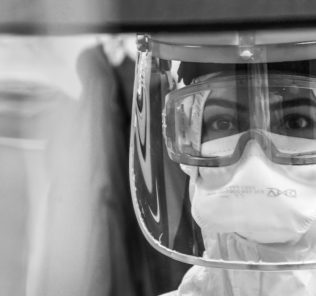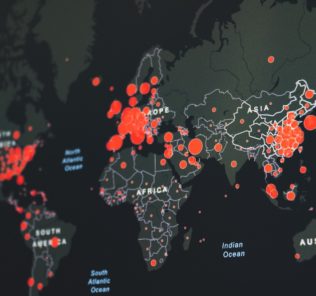Latest Medical Simulation Research Focused on COVID-19
The latest medical simulation research covering COVID-19 is being shared to HealthySimulation.com from healthcare research professionals all around the world. Today we share some of the latest Coronavirus healthcare simulation research covering reopening simulation centers, improving ED Airway preparedness, case studies — and with many more links available on our Clinical Simulation COVID-19 Page. Do you have recommendations for additional COVID-19 research which utilizes or supports simulation in healthcare? Email us and let us know!
COVID-19 crisis, safe reopening of simulation centres and the new normal: food for thought (Ingrassia et al.): The world is facing a massive burden from the coronavirus disease 2019 (COVID-19) pandemic. Governments took the extraordinary step of locking down their own countries to curb the spread of the coronavirus. After weeks of severe restrictions, countries have begun to relax their strict lockdown measures. However, reopening will not be back to normal, especially for simulation centres. Simulation facilities (SF) are training spaces that enable health professionals and students to learn skills and procedures in a safe and protected environment.
Today’s clinicians and students have an expectation that simulation laboratories are part of lifelong healthcare education. There is great uncertainty about how COVID-19 will impact future training in SF. In particular, the delivery of training activities will benefit of adequate safety measures implemented for all individuals involved. This paper discusses how to safely reopen SF in the post-lockdown phase. The planning of future activities will have to be based not only on safety but also on flexibility principles. Sharing common methods consistent with national and international health guidelines, while taking into account the specific characteristics of the different contexts and centres, will ultimately foster dissemination of good practices.
Sponsored Content:
Improving Emergency Department Airway Preparedness in the Era of COVID-19: An Interprofessional, In Situ Simulation (Warner et al.): It is essential to train ED staff (1) to appropriately care for patients with suspected COVID-19 disease and (2) to provide an organized, safe working environment for providers during high-risk, aerosolizing procedures such as intubation. In addition to providing a set of airway management guidelines, we aimed to educate the staff through participation in a simulation activity. Due to the multiple team members involved and the array of equipment needed, an in-person in situ strategy was implemented.
The goals of the simulation were to optimize patient care and minimize viral exposure to those involved during intubation. This simulation was an effective, easy-to-implement method of interprofessional team training for a risk-inherent procedure in the ED. We learned that the deliberate simulation of each step of the COVID19-specific intubation procedure with all team members provided opportunities to identify safety challenges in communication, equipment, and approach. Each debrief stimulated an excellent discussion among team members, and allowed for interprofessional feedback, clarification of questions, and recommendations for areas of improvement. Our main take-away from the pilot of this novel simulation case is that new, high-risk procedures require a coordinated team effort to minimize risks to patients and staff, and that team training is feasible and effective using frequent in situ simulations.
Healthcare simulation to prepare for the COVID-19 pandemic (Andreae et al.): COVID-19 challenged providers and organization with unfamiliar and unprecedented scenarios. This group simulated anticipated airborne contagion scenarios to familiarize providers with safe practices. • COVID-19 procedures were safely examined in realistic situations and modified based on participant debriefings. Simulation promoted interdisciplinary integration of our organizational response to COVID-19.
This article was followed by another from the same team: Data and Debriefing Observations on Healthcare Simulation to Prepare for the COVID-19 Pandemic, which reports on data and debriefing observations in the context of an immersive simulation conducted to (a) train clinicians and (b) test new protocols and kits, developed in table-top exercises without prior clinical experience to fit anticipated clinical encounters in the setting of the rapidly expanding COVID-19 pandemic. The team simulated scenarios with particular relevance for anesthesiology, perioperative and critical care, including (1) cardiac arrest, (2) emergency airway management, (3) tele-instruction for remote guidance and supervision, and (4) transporting an intubated patient.
Sponsored Content:
“Human Patient Simulation: Educational Issues and Practical Implications in COVID-19 Times” Letter to the Editor (Moscote-Salazar et al.): The COVID-19 pandemic has provided a unique opportunity for the use of simulations, building on their strengths. The use of simulations has tremendous potential to help manage the worldwide COVID-19 emergency in 2020 and, conceivably, comparative future pandemics. The use of simulations could quickly encourage emergency clinic readiness and can provide instruction from huge numbers of medical service experts to students at different levels.
Simulations have demonstrated their effectiveness in numerous settings. Simulations could also be used to educate persons through experiential learning to increase the workforce available. Therefore, universities must assertively engage in simulation development and technology integration to optimally acquire the resources necessary and prepare protocols required to implement such programs on their campuses. With a comprehensive approach, the use of simulation could help alleviate the negative effects of the COVID-19 emergency and, conceivably, could be used in future emergency circumstances.
COVID-19 ICU Respiratory Simulator Training White Paper Case Study (Junge et al.): The Institute of Patient Safety and Simulation of the state of Grisons, Switzerland (Graubündner Institut für Patientensicherheit und Simulation, GRIPS) was commissioned to produce training programs in the application of respiratory care for patients with COVID-19 when the COVID-19 pandemic was first declared an emergency in Switzerland. These training programs covered the safe use of intensive care ventilators, non-invasive ventilation techniques (NIV), and high flow oxygen therapy. Not only were trainees in these areas to be taught the basic skills in using those techniques, they were also to be taught how patients may or may not respond to those techniques.
Translational simulation for rapid transformation of health services, using the example of the COVID-19 pandemic preparation (Brazil et al.): Healthcare simulation has significant potential for helping health services to deal with the COVID-19 pandemic. Rapid changes to care pathways and processes needed for protection of staff and patients may be facilitated by a translational simulation approach—diagnosing changes needed, developing and testing new processes and then embedding new systems and teamwork through training. However, there are also practical constraints on running in situ simulations during a pandemic—the need for physical distancing, rigorous infection control for manikins and training equipment and awareness of heightened anxiety among simulation participants.
The team will describe their institution’s simulation strategy for COVID-19 preparation and reflect on the lessons learned—for simulation programs and for health services seeking to utilize translational simulation during and beyond the COVID-19 pandemic. They offer practical suggestions for a translational simulation strategy and simulation delivery within pandemic constraints. They also suggest simulation programs develop robust strategies, governance and relationships for managing change within institutions—balancing clinician engagement, systems engineering expertise and the power of translational simulation for diagnosing, testing and embedding changes.
Additional COVID-19 Articles Relevant to Healthcare Simulation:
- Even More Helpful COVID19 Healthcare Simulation Resources
- COVID-19 Causes National Emergency in Healthcare Education
- Additional Responses to the Coronavirus from the Medical Simulation Industry
- Healthcare Simulation Industry Responds to Coronavirus COVID-19
- Coronavirus Simulation Resources: Scenarios, Online Training, Procedures Guide
- HHS Whistleblower Complaint Demonstrates Immediate Need for Medical Simulation Coronavirus Training
- Suspected COVID-19 Simulation Scenario from CAE Healthcare, New WHO Resources & More
Visit Our COVID-19 Medical Simulation Resource Page for a Complete List!
Lance Baily, BA, EMT-B, is the Founder & CEO of HealthySimulation.com, which he started while serving as the Director of the Nevada System of Higher Education’s Clinical Simulation Center of Las Vegas back in 2010. Lance is also the Founder and acting Advisor to the Board of SimGHOSTS.org, the world’s only non-profit organization dedicated to supporting professionals operating healthcare simulation technologies. His co-edited Book: “Comprehensive Healthcare Simulation: Operations, Technology, and Innovative Practice” is cited as a key source for professional certification in the industry. Lance’s background also includes serving as a Simulation Technology Specialist for the LA Community College District, EMS fire fighting, Hollywood movie production, rescue diving, and global travel. He and his wife Abigail Baily, PhD live in Las Vegas, Nevada with their two amazing daughters.
Sponsored Content:





















